What happened at Lexington and Concord?
Meanwhile, the British declared Massachusetts—with its rebel counties and shadow government—to be in a state of open rebellion.
On the evening of 18 April, Thomas Gage secretly ordered a contingent of around seven hundred British regulars to march to Concord and seize military supplies allegedly being stored there by the colonial militia. (Having received intelligence that these supplies were in danger, the militia had actually moved most of them weeks before.) Paul Revere and other riders fanned out into the countryside, warning colonists of the soldiers’ coming and readying “minutemen” (militia members prepared to respond instantly if required) to defend the area. All of this took place during the night, so that by sunrise Lexington’s militia (a rather grand name for a collection of poorly-trained farmers, including old men and young boys) had gathered on the village green.
It was around this time that the redcoats marched by—and someone fired. The British fired back in a disciplined volley, and in a moment eight colonials lay dead on the ground, compared to only one redcoat casualty. Outnumbered, the Lexington militia fell back.

